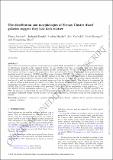Files in this item
The distribution and morphologies of Fornax Cluster dwarf galaxies suggest they lack dark matter
Item metadata
| dc.contributor.author | Asencio, Elena | |
| dc.contributor.author | Banik, Indranil | |
| dc.contributor.author | Mieske, Steffen | |
| dc.contributor.author | Venhola, Aku | |
| dc.contributor.author | Kroupa, Pavel | |
| dc.contributor.author | Zhao, Hongsheng | |
| dc.date.accessioned | 2022-06-28T15:30:02Z | |
| dc.date.available | 2022-06-28T15:30:02Z | |
| dc.date.issued | 2022-09-01 | |
| dc.identifier | 280273338 | |
| dc.identifier | 06c91713-ecf3-49fc-b6fa-f5317f0c7416 | |
| dc.identifier | 85136223157 | |
| dc.identifier | 000836408700001 | |
| dc.identifier.citation | Asencio , E , Banik , I , Mieske , S , Venhola , A , Kroupa , P & Zhao , H 2022 , ' The distribution and morphologies of Fornax Cluster dwarf galaxies suggest they lack dark matter ' , Monthly Notices of the Royal Astronomical Society , vol. 515 , no. 2 , stac1765 , pp. 2981–3013 . https://doi.org/10.1093/mnras/stac1765 | en |
| dc.identifier.issn | 0035-8711 | |
| dc.identifier.other | Bibtex: 10.1093/mnras/stac1765 | |
| dc.identifier.other | ORCID: /0000-0002-4123-7325/work/116910465 | |
| dc.identifier.other | ArXiv: http://arxiv.org/abs/2208.02265v1 | |
| dc.identifier.uri | https://hdl.handle.net/10023/25573 | |
| dc.description | Funding: EA is supported by a stipend from the Stellar Populations and Dynamics Research Group at the University of Bonn. IB is supported by Science and Technology Facilities Council grant ST/V000861/1, which also partially supports HZ. IB acknowledges support from a “Pathways to Research” fellowship from the University of Bonn. PK acknowledges support through the Deutscher Akademischer Austauschdienst Eastern European Exchange Programme. | en |
| dc.description.abstract | Due to their low surface brightness, dwarf galaxies are particularly susceptible to tidal forces. The expected degree of disturbance depends on the assumed gravity law and whether they have a dominant dark halo. This makes dwarf galaxies useful for testing different gravity models. In this project, we use the Fornax Deep Survey (FDS) dwarf galaxy catalog to compare the properties of dwarf galaxies in the Fornax Cluster with those predicted by the Lambda cold dark matter (ΛCDM) standard model of cosmology and Milgromian dynamics (MOND). We construct a test particle simulation of the Fornax system. We then use the Markov Chain Monte Carlo (MCMC) method to fit this to the FDS distribution of tidal susceptibility η (half-mass radius divided by theoretical tidal radius), the fraction of dwarfs that visually appear disturbed as a function of η, and the distribution of projected separation from the cluster centre. This allows us to constrain the η value at which dwarfs should get destroyed by tides. Accounting for an r′-band surface brightness limit of 27.8 magnitudes per square arcsecond, the required stability threshold is ηdestr=0.25+0.07−0.03 in ΛCDM and 1.88+0.85−0.53 in MOND. The ΛCDM value is in tension with previous N-body dwarf galaxy simulations, which indicate ηdestr ≈ 1. Our MOND N-body simulations indicate ηdestr = 1.70 ± 0.30, which agrees well with our MCMC analysis of the FDS. We therefore conclude that the observed deformations of dwarf galaxies in the Fornax Cluster and the lack of low surface brightness dwarfs towards its centre are incompatible with ΛCDM expectations but well consistent with MOND. | |
| dc.format.extent | 33 | |
| dc.format.extent | 7175779 | |
| dc.language.iso | eng | |
| dc.relation.ispartof | Monthly Notices of the Royal Astronomical Society | en |
| dc.subject | Gravitation | en |
| dc.subject | Dark matter | en |
| dc.subject | Galaxies: clusters: indivudal: Fornax | en |
| dc.subject | Galaxies: dwarf | en |
| dc.subject | Galaxies: interactions | en |
| dc.subject | Galaxies: statistics | en |
| dc.subject | QB Astronomy | en |
| dc.subject | QC Physics | en |
| dc.subject | 3rd-DAS | en |
| dc.subject | MCC | en |
| dc.subject.lcc | QB | en |
| dc.subject.lcc | QC | en |
| dc.title | The distribution and morphologies of Fornax Cluster dwarf galaxies suggest they lack dark matter | en |
| dc.type | Journal article | en |
| dc.contributor.institution | University of St Andrews. School of Physics and Astronomy | en |
| dc.identifier.doi | https://doi.org/10.1093/mnras/stac1765 | |
| dc.description.status | Peer reviewed | en |
This item appears in the following Collection(s)
Items in the St Andrews Research Repository are protected by copyright, with all rights reserved, unless otherwise indicated.

